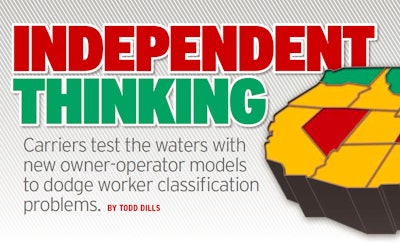

Challenges to independent contractor status for leased owner-operators continue to crop up at state and federal levels. The most recent major threats came during the previous U.S. Congress in 2009 and 2010, when bills were proposed to gut tax relief nationwide for companies utilizing ICs.
The legislative threat is not urgent at the moment, but some parties are exploring other business models for how fleets use owner-operators. Two in particular could enhance protection from classification problems for the carrier and bolster business freedom for the owner-operator.
From leased to independent
For most carriers leasing owner-operators, avoiding problems with independent contractor classification usually involves three points, says TrueNorth Companies Senior Transportation Specialist Trent Tillman:
• Complying with federal leasing regulations,
• Using the right kind of language in lease contracts, and
• Determining an appropriate level of control over owner-operators.
Some carriers have gone much further, trying innovative approaches. One alternative is to convert leased independent contractors to owner-operators functioning under their own authority as dedicated or semi-dedicated carriers under contract with a freight forwarder entity.
Rudolph Freight Systems, based in Murray, Ky., is an example. Prior to obtaining freight forwarder authority, says President Robbie Rudolph, the carrier leased approximately 100 trucks. Being aware of independent contractor classification issues as well as the Compliance, Safety, Accountability program’s focus on safety tracking, Rudolph wanted to safeguard all parties.
“I was working on something that would protect the shipper customer, our power provider [owner-operators] and us,” he says.
He worked with TrueNorth, lawyers and safety consultants to get motor carrier authority for Rudolph’s leased owner-operators and small fleets, as well as relevant insurance coverage and safety consulting to help them avoid CSA problems. Today the newly independent owner-operators largely operating as dedicated carriage for the Rudolph freight-forwarding operation have access to improved insurance programs, says Rudolph. “And we provide better, more convenient service to the power provider,” with commercial auto liability and other policies tailored for each individual owner-operator in a manner similar to what many traditional carriers do for leased owner-operators’ non-trucking liability, physical damage and occupational-accident policies.
In this model, Rudolph becomes not only a freight logistics provider but a vehicle for owner-operator support, utilizing connections to preferred service providers to help the small businesses be more efficient and safe.
Rudolph’s not the only example. “We are in talks with a few carriers on the freight-forwarder model and actually going through a conversion with one carrier,” says Todd Amen, principal with owner-operator business services provider ATBS. “I believe the freight-forwarder model is not a fad, but I also believe there is significant additional cost to it that the general freight industry can’t currently afford.”
As anybody who’s gone out on his own with his DOT authority knows, those additional costs can add up quickly. Added costs for owner-operators include those typically associated with getting your own authority: insurance, maintaining compliance and potential administrative expenses of obtaining authority and incorporating the business, Amen says.
Borne by the former leased owner-operators in the freight forwarder model, Amen suggests, these costs will ultimately exceed what a carrier is likely to spend cumulatively on the same number of leased power units. In general, Amen believes rates are not sufficiently high to make this model attractive enough to most owner-operator fleets. “It will likely only apply in specific niche businesses that have higher perceived risk [of independent contractor challenges] and can afford to implement the model to offset for the foreseeable future,” says Amen. “I believe the trend is economically and politically driven, and some of those pressures seem to have subsided over the last six to 12 months.”
But at Rudolph, working in general freight, the transition for the operators was fairly simple, says recruiter E.W. Dennison. Costs for the owner-operators rose only marginally. “We’ve always required workers compensation insurance or occupational accident,” he says, as well as general liability. Rudolph now covers higher cargo insurance premiums for their power providers, and new commercial auto liability requirements for the newly independent owner-operators were affordable with savings in other areas and a boost of a few cents in mileage pay. “From their standpoint,” Dennison adds, with the exception of an extra paperwork step with bills of lading, “their lives didn’t change at all.”
Leasing through another party
Cleveland-based attorney Richard Plewacki describes a leasing model in which an independent entity, a “transportation agent” (TA), sits between the carrier and its independent contractors.
This model may gain traction as an alternative to traditional owner-operator independent contractor arrangements if carrier worries over control challenges continue to intensify.
It works like a traditional lease, but there’s a middleman – the TA – who holds a contract with the owner-operator and the carrier. The carrier is utilizing the TA to outsource most of its administrative functions as they relate to the independent contractors. Still, “the rights and benefits” afforded the contractor by the federal Truth in Leasing regulations “have to be in place,” says Plewacki. In the contract between the TA and the motor carrier, the TA agrees to take on the responsibility of ensuring that “the owner-operators he brings to the table have legal right to the equipment,” Plewacki adds, “and that they’re DOT-qualified.”
When an owner-operator contracts with the TA, he agrees to comply with whatever “spec sheet” the TA has agreed to with the motor carrier. The spec sheet, Plewacki says, may include items such as the required use of certain communications devices or standards for powered equipment.
Variations in the TA-owner-operator contract could enhance independent contractor freedom, Plewacki says, further protecting all parties from classification challenges. For example, “the transportation agent may require that the owner-operator doesn’t put the motor carrier on the base plate,” he says. “The same could be true for an IFTA account, ultimately giving the owner-operator more flexibility to work for others.”
Arizona-based Contractor Management Services (ICtherightway.com) is moving in the direction of the model that Plewacki describes, says Executive Vice President Scott Glandys. Today, the company acts “as a clearinghouse,” he adds, taking over the validation of owner-operator credentials for carriers during the signing-on process and monitoring those credentials during the owner-operator’s term with the carrier, making the company something of a third-party relationship service provider rather than pure transportation agent.
Getting closer to Plewacki’s description of the TA model, the company plans to “leverage our software and services to create that front-end recruiting,” Glandys says. Owner-operators will be able to “use the system to find a motor carrier, and vice versa.” An individual owner-operator’s qualification file will be maintained “with constant monitoring” as long as the operator has a contract with CMS, streamlining the matching process for carriers and owner-operators alike. This holds the potential to make changing carriers much more easy for owner-operators, eliminating much of the recurring costs for switching, Glandys says.
CMS is also “plugging in with partners that will provide discounted services,” anything from various insurance policies to “things such as getting operating authority set up,” he says, to help operators as their businesses evolve. Further, facilitation of trip-lease agreements is on CMS’ radar – helping carriers work together when an IC who may not have his own authority is going to run under another carrier’s authority.
Goal of greater freedom
These new approaches to using owner-operators would help eliminate what National Association of Small Trucking Companies President David Owen says is a central problem for carriers utilizing ICs. “Based solely on the criteria of the IRS, there’s no real 1099 independent contractor at a carrier where owner-operators are under the control of dispatchers or fleet managers,” he says, referring to the tax Form 1099 earnings reports companies supply independent contractors.
But carriers have long had “safe harbor” from some of the right-of-control rules based on Section 530 of the Internal Revenue Service code. The section spells out requirements for companies utilizing independent contractors. The safe harbor provision makes the prevalence of the IC classification in a particular industry a reasonable basis for classifying workers as ICs.
Without the provision, which would have been gutted by recent attempts at federal legislation addressing IC classification, companies utilizing leased owner-operators wouldn’t be able to do so without significant contract changes.
Bills to change classification rules to the detriment of carriers utilizing independents were introduced in each Congress after the Democrats took both houses in 2006. Mired in a battle over the federal debt and how to revive the economy, the current split-party Congress appears unlikely to take action on IC status. Plewacki characterizes the lull as a time to think about ways to enhance owner-operator freedom in current leases and examine new models.
States continue to wrestle with IC issues, says Greg Feary, an expert on IC classification law with the Indianapolis-based Scopelitis law firm. “In the last year and a half there have been many [decisions] that support independent contractor status for owner-operators,” he says.
The big question, he says, is when efforts to erode Section 530 relief at the federal level will return. “It just depends on the makeup of the Congress, generally. If the federal legislators are more Republican than Democratic, you might not see as many efforts in that area.”
State workers comp rules related to independent contractors
Workers compensation disputes are a primary source for independent contractor classification challenges. The foundation for this map, outlined by the TrueNorth Companies, is the comprehensive case law research of Greg Feary, with the Scopelitis law firm. Given the interstate nature of most truckload carriers, just because a carrier is based in a particular state doesn’t mean that carrier doesn’t have to worry about other states’ rules. If an injured owner-operator wants to file a suit against his carrier for workers comp benefits, says TrueNorth’s Trent Tillman, “he can file in the state where he lives, in the state where the motor carrier is based or the state where he got injured.”
* Statute or rigorous case law requires companies utilizing independent contractors to provide workers compensation insurance for them or at least require that contractors purchase it themselves.
* Statute exempts carriers utilizing independent contractors from workers compensation responsibilities.
* No specific statute exists relative to workers compensation and independent contractors, but case law may be pertinent in particular instances.
Challenges to IC status usually due to IRS, injury or union activity
Challenges to independent contractor status can come from the Internal Revenue Service during company tax audits. The U.S. Department of Labor can be involved, and it uses a more stringent and thorough so-called “economic realities test” to determine whether a group of independent contractors is valid or not. “At the state level is where the complexity starts to come in,” says Trent Tillman of TrueNorth. “It’s a diverse world out there.”
An independent contractor getting hurt has often “been one of the main reasons other cans of worms get opened up,” says Tillman. “Say the motor carrier didn’t have an occupational accident insurance program available, and the owner-operator didn’t have insurance of his own, and therefore he files a [workers compensation] lawsuit against the company, saying he needs to be reclassified as an employee.” In Colorado and Nevada, he says, “that’s worked, and as soon as it does, there’s case law” supporting other such cases.
Lose an individual workers compensation case in states where workers compensation laws are aggressive, such as Arkansas and North Carolina, Tillman adds, and a carrier may face more problems. “Now the work comp people are talking to the unemployment compensation division, saying, ‘You might want to look at them for collection of unemployment tax.’ I know some motor carriers who’ve gotten bills from the state saying ‘you haven’t been paying unemployment tax to the state’” for their entire IC group after a single reclassification case.
Union pressure, particularly among drayage haulers, also can spawn IC-classification investigations when a contracting owner-operator or group of contractors files a complaint against their carrier for issues related to compensation or benefits. “In California, Teamsters are getting groups of owner-operators together and going to the court and saying they’re being abused,” often taking advantage of immigrants’ lack of understanding of U.S. labor law, Tillman says.
Tropical Shipping Trucking Systems Supervisor Dennis Thies says rumors a few years back mentioned union activity at the Port of Palm Beach, Fla., from which most of his company’s near 100 owner-operators run. “Our drivers are happy working here,” he says of his company, a big factor in avoiding classification problems. “A majority of our drivers have been here about 15 or more years.”
Tropical owner-operator Rod Seymore, running intermodal containers for the company since 1996, notes the IC classification issue is paramount for any union that wants to expand its strength. “If you’re an owner-operator, you’re an independent contractor,” he says. “I don’t think a union is much of a benefit.”
Challenges to independent contractor status for leased owner-operators continue to crop up at state and federal levels. The most recent major threats came during the previous U.S. Congress in 2009 and 2010, when bills were proposed to gut tax relief nationwide for companies utilizing ICs.
The legislative threat is not urgent at the moment, but some parties are exploring other business models for how fleets use owner-operators. Two in particular could enhance protection from classification problems for the carrier and bolster business freedom for the owner-operator.
From leased to independent
For most carriers leasing owner-operators, avoiding problems with independent contractor classification usually involves three points, says TrueNorth Companies Senior Transportation Specialist Trent Tillman:
• Complying with federal leasing regulations,
• Using the right kind of language in lease contracts, and
• Determining an appropriate level of control over owner-operators.
Some carriers have gone much further, trying innovative approaches. One alternative is to convert leased independent contractors to owner-operators functioning under their own authority as dedicated or semi-dedicated carriers under contract with a freight forwarder entity.
Rudolph Freight Systems, based in Murray, Ky., is an example. Prior to obtaining freight forwarder authority, says President Robbie Rudolph, the carrier leased approximately 100 trucks. Being aware of independent contractor classification issues as well as the Compliance, Safety, Accountability program’s focus on safety tracking, Rudolph wanted to safeguard all parties.
“I was working on something that would protect the shipper customer, our power provider [owner-operators] and us,” he says.
He worked with TrueNorth, lawyers and safety consultants to get motor carrier authority for Rudolph’s leased owner-operators and small fleets, as well as relevant insurance coverage and safety consulting to help them avoid CSA problems. Today the newly independent owner-operators largely operating as dedicated carriage for the Rudolph freight-forwarding operation have access to improved insurance programs, says Rudolph. “And we provide better, more convenient service to the power provider,” with commercial auto liability and other policies tailored for each individual owner-operator in a manner similar to what many traditional carriers do for leased owner-operators’ non-trucking liability, physical damage and occupational-accident policies.
In this model, Rudolph becomes not only a freight logistics provider but a vehicle for owner-operator support, utilizing connections to preferred service providers to help the small businesses be more efficient and safe.
Rudolph’s not the only example. “We are in talks with a few carriers on the freight-forwarder model and actually going through a conversion with one carrier,” says Todd Amen, principal with owner-operator business services provider ATBS. “I believe the freight-forwarder model is not a fad, but I also believe there is significant additional cost to it that the general freight industry can’t currently afford.”
As anybody who’s gone out on his own with his DOT authority knows, those additional costs can add up quickly. Added costs for owner-operators include those typically associated with getting your own authority: insurance, maintaining compliance and potential administrative expenses of obtaining authority and incorporating the business, Amen says.
Borne by the former leased owner-operators in the freight forwarder model, Amen suggests, these costs will ultimately exceed what a carrier is likely to spend cumulatively on the same number of leased power units. In general, Amen believes rates are not sufficiently high to make this model attractive enough to most owner-operator fleets. “It will likely only apply in specific niche businesses that have higher perceived risk [of independent contractor challenges] and can afford to implement the model to offset for the foreseeable future,” says Amen. “I believe the trend is economically and politically driven, and some of those pressures seem to have subsided over the last six to 12 months.”
But at Rudolph, working in general freight, the transition for the operators was fairly simple, says recruiter E.W. Dennison. Costs for the owner-operators rose only marginally. “We’ve always required workers compensation insurance or occupational accident,” he says, as well as general liability. Rudolph now covers higher cargo insurance premiums for their power providers, and new commercial auto liability requirements for the newly independent owner-operators were affordable with savings in other areas and a boost of a few cents in mileage pay. “From their standpoint,” Dennison adds, with the exception of an extra paperwork step with bills of lading, “their lives didn’t change at all.”
Leasing through another party
Cleveland-based attorney Richard Plewacki describes a leasing model in which an independent entity, a “transportation agent” (TA), sits between the carrier and its independent contractors.
This model may gain traction as an alternative to traditional owner-operator independent contractor arrangements if carrier worries over control challenges continue to intensify.
It works like a traditional lease, but there’s a middleman – the TA – who holds a contract with the owner-operator and the carrier. The carrier is utilizing the TA to outsource most of its administrative functions as they relate to the independent contractors. Still, “the rights and benefits” afforded the contractor by the federal Truth in Leasing regulations “have to be in place,” says Plewacki. In the contract between the TA and the motor carrier, the TA agrees to take on the responsibility of ensuring that “the owner-operators he brings to the table have legal right to the equipment,” Plewacki adds, “and that they’re DOT-qualified.”
When an owner-operator contracts with the TA, he agrees to comply with whatever “spec sheet” the TA has agreed to with the motor carrier. The spec sheet, Plewacki says, may include items such as the required use of certain communications devices or standards for powered equipment.
Variations in the TA-owner-operator contract could enhance independent contractor freedom, Plewacki says, further protecting all parties from classification challenges. For example, “the transportation agent may require that the owner-operator doesn’t put the motor carrier on the base plate,” he says. “The same could be true for an IFTA account, ultimately giving the owner-operator more flexibility to work for others.”
Arizona-based Contractor Management Services (ICtherightway.com) is moving in the direction of the model that Plewacki describes, says Executive Vice President Scott Glandys. Today, the company acts “as a clearinghouse,” he adds, taking over the validation of owner-operator credentials for carriers during the signing-on process and monitoring those credentials during the owner-operator’s term with the carrier, making the company something of a third-party relationship service provider rather than pure transportation agent.
Getting closer to Plewacki’s description of the TA model, the company plans to “leverage our software and services to create that front-end recruiting,” Glandys says. Owner-operators will be able to “use the system to find a motor carrier, and vice versa.” An individual owner-operator’s qualification file will be maintained “with constant monitoring” as long as the operator has a contract with CMS, streamlining the matching process for carriers and owner-operators alike. This holds the potential to make changing carriers much more easy for owner-operators, eliminating much of the recurring costs for switching, Glandys says.
CMS is also “plugging in with partners that will provide discounted services,” anything from various insurance policies to “things such as getting operating authority set up,” he says, to help operators as their businesses evolve. Further, facilitation of trip-lease agreements is on CMS’ radar – helping carriers work together when an IC who may not have his own authority is going to run under another carrier’s authority.
Goal of greater freedom
These new approaches to using owner-operators would help eliminate what National Association of Small Trucking Companies President David Owen says is a central problem for carriers utilizing ICs. “Based solely on the criteria of the IRS, there’s no real 1099 independent contractor at a carrier where owner-operators are under the control of dispatchers or fleet managers,” he says, referring to the tax Form 1099 earnings reports companies supply independent contractors.
But carriers have long had “safe harbor” from some of the right-of-control rules based on Section 530 of the Internal Revenue Service code. The section spells out requirements for companies utilizing independent contractors. The safe harbor provision makes the prevalence of the IC classification in a particular industry a reasonable basis for classifying workers as ICs.
Without the provision, which would have been gutted by recent attempts at federal legislation addressing IC classification, companies utilizing leased owner-operators wouldn’t be able to do so without significant contract changes.
Bills to change classification rules to the detriment of carriers utilizing independents were introduced in each Congress after the Democrats took both houses in 2006. Mired in a battle over the federal debt and how to revive the economy, the current split-party Congress appears unlikely to take action on IC status. Plewacki characterizes the lull as a time to think about ways to enhance owner-operator freedom in current leases and examine new models.
States continue to wrestle with IC issues, says Greg Feary, an expert on IC classification law with the Indianapolis-based Scopelitis law firm. “In the last year and a half there have been many [decisions] that support independent contractor status for owner-operators,” he says.
The big question, he says, is when efforts to erode Section 530 relief at the federal level will return. “It just depends on the makeup of the Congress, generally. If the federal legislators are more Republican than Democratic, you might not see as many efforts in that area.”
Transportation agent

Transportation Agent
• Independent entity that contracts with carrier and agrees to provide independent contractors
• Contracts with owner-operator and provides settlement and/or other services with all deductions spelled out in the contract
• Is paid by the carrier either on a flat weekly rate per contractor or in an incentivizing mileage or percentage basis to encourage workforce stability
Owner-operator
• Contracts with transportation agent, agreeing to lease equipment under the motor carrier’s authority
• Agrees to carrier’s operational requirements and to supply driver
Motor carrier
• Contracts with the transportation agent, specifying requirements of owner-operators.
• Typically leaves to the transportation agent the right to provide most service, except for freight/dispatch capability and motor carrier authority










